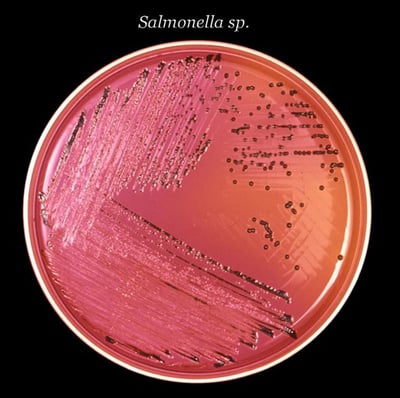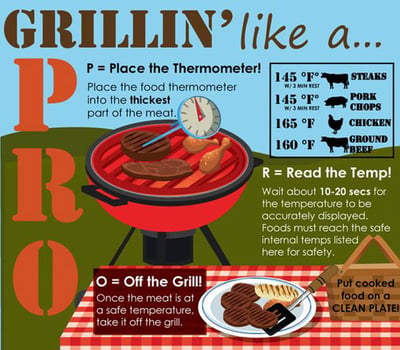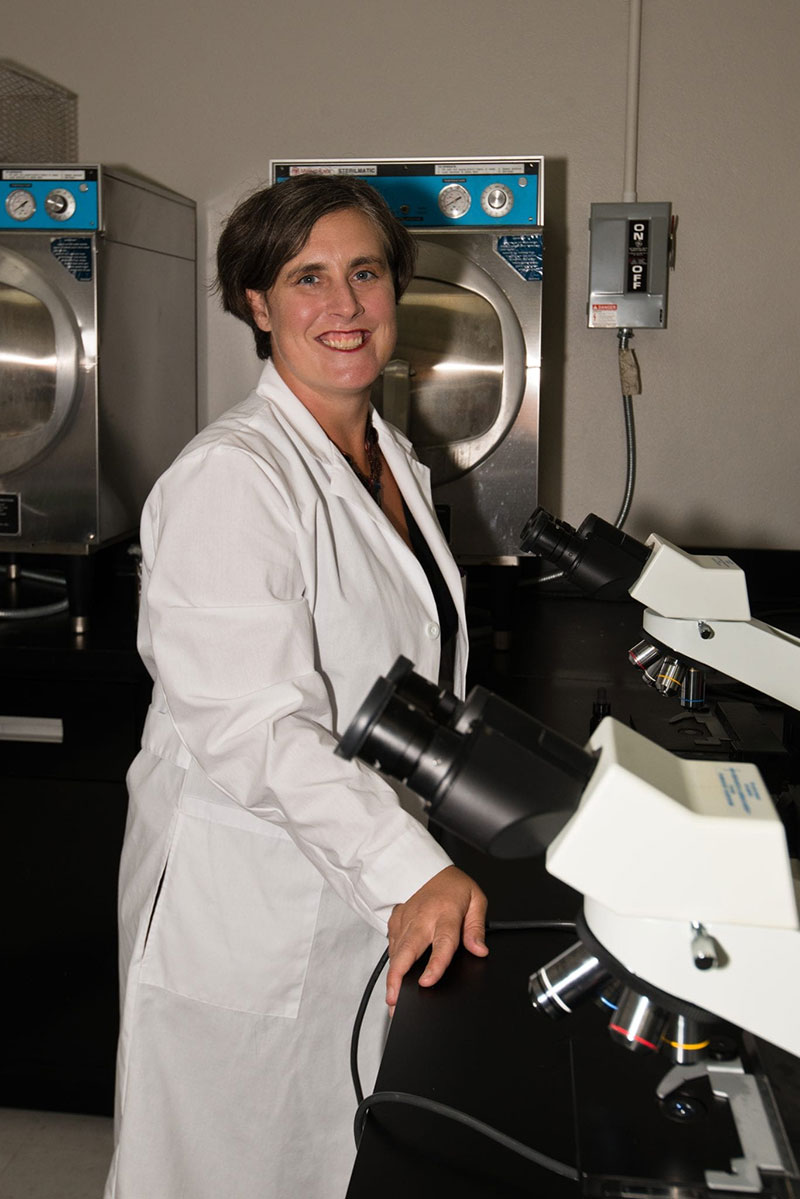UMHS PROFESSOR DR. JANE HARRINGTON: Assistant Professor of Microbiology and Immunology gave a presentation at the 4th St. Kitts and Nevis One Health Symposium, 'Food Safety--From Farm to Table in the Federation of St. Kitts and Nevis.' Pictured: Dr. Harrington at work on the UMHS St. Kitts campus. Photo: Ian Holyoak
Dr. Jane Harrington, UMHS Assistant Professor of Microbiology and Immunology, spoke at the 4th St. Kitts and Nevis One Health Symposium, “Food Safety—From Farm to Table in the Federation of St. Kitts and Nevis” on July 30, 2015 at Ross University School of Veterinary Medicine, in collaboration with UMHS and Windsor University School of Medicine.
The UMHS Endeavour recently spoke to Dr. Harrington about food safety, specifically regarding chicken and beef and ways to avoid catching salmonella, e-coli and other food-borne illnesses.
In the presentation, Dr. Harrington discussed such aspects of food safety as government regulation from the Food and Drug Administration (FDA) and U.S. Department of Agriculture’s Food Safety and Inspection Services (USDA-FSIS), “acceptable” levels of salmonella contamination by USDA-FSIS, USDA-FSIS inspection, and why failed inspections by USDA-FSIS are common. In addition, Dr. Harrington talked about voluntary recalls of poultry products, citing outbreaks involving Cargill and California-based Foster Farms.
During our interview with Dr. Harrington, she discussed a fascinating Frontline documentary on PBS, “The Trouble with Chicken,” which chronicles the dangerous pathogen salmonella Heidelberg and how chicken sold by Foster Farms sickened hundreds of people during two different outbreaks in 2004 and 2013. The documentary is eye-opening because it shows how Foster Farms failed to make adjustments to food safety despite warnings from the Food and Drug Administration and others after the first outbreak in 2004. Salmonella, according to the documentary, sickens an estimated one million per year, with 200,000 becoming ill from contaminated poultry.
Federal inspectors visit poultry plants all over America, but many fail to identify salmonella. “The Trouble With Chicken” examines what’s wrong with our current system. The documentary looks at the U.S. Department of Agriculture’s Food Safety and Inspection Service (FSIS) and includes an alarming history of food safety in the USA. “The Trouble With Chicken” reports on many of the issues that Dr. Harrington explored in “USDA Approved, Modern-Day Russian Roulette.”
The UMHS Endeavour caught up with Dr. Harrington to discuss her presentation, food safety, food in St. Kitts, the complications with government regulation, and more.
UMHS ENDEAVOUR: Tell us about your presentation "USDA Approved, Modern-Day Russian Roulette" at the 4th St. Kitts and Nevis One Health Symposium, "Food Safety from Farm to Table in the Federation of St. Kitts and Nevis." Why did you choose the title "Modern-Day Russian Roulette"?
DR. JANE HARRINGTON: I was illustrating with numbers for whenever you purchase poultry products. It’s a numbers game. If you are purchasing ground turkey, for instance. I make ground turkey burgers that I feed to my child. I am playing Russian roulette. Whenever I’m making ground turkey burgers, I know there’s a 50 percent chance I could give my daughter salmonella. That’s with compliance with the Food and Drug Administration (FDA) and United States Department of Agriculture (USDA). One of the points that I was making was if you look at the FDA and USDA records, a lot of these major corporations---I’m talking about Foster Farms and Cargill--they do not comply to that 50 percent so the reality is, if you’re in the United States, when you buy ground turkey or ground chicken, we’re talking about very, very high odds that I’m giving my daughter salmonella [if meat is not fully cooked].
If you then take that situation and you put it where we live, in St. Kitts. Sometimes, food travels from China to the United States and then to St. Kitts, for example.
Whenever I go to the grocery store, I know that frozen products have been thawed. Whenever they stock items, they put the products in the aisles and they thaw. I see ice cream with the crystallization because it has thawed and been re-frozen. So if there was one [product] with salmonella present whenever it left the factory a month ago, whenever it actually gets into our grocery stores, that salmonella has gotten to a much higher load because it’s had temperature variability to replicate. I hypothesize that the numbers for Russian roulette then become much more dramatic for American imported poultry products in St. Kitts and chances increase for a strain of salmonella that’s very virulent.
The USDA might know about it but the farm that is right next to the Cargill plants that’s being affected by the water runoff and they use the water for the irrigation to then water the plants, that’s the FDA’s problem. I was making the point that they don’t have a streamlined communication system for the outbreaks and the recalls. The FDA has no power for recalls. The FDA can approach but regarding salmonella outbreaks, both the FDA and the USDA, what they consider the parameters for the suggesting a recall are pretty minor. If the FDA finds a recall for a spinach EHEC [Enterohaemorrhagic Escherichia coli] outbreak, the FDA cannot go back to the population where the cows were and have them address that.
In the presentation, I tried to focus on St. Kitts specifically. We have local production here. We don’t have high salmonella incidences here. The animals here are not endemic reservoirs for salmonella. They just don’t have it here. We have salmonella but it’s not these crazy antibiotic resistant strains. For our poultry products here, they don’t use antibiotics. It’s a waste of money for them.
It’s much more organic there, right?
I specifically use this one example of a particular chicken farmer I go to in Nevis. I know the guy. I’ve seen the chickens. They’re not chickens in a crowded, very unhealthy mass production farm. They’re exposed to light. It’s much more basic animal farming that’s been around a long time. He slaughters the animals and puts them in a deep freezer immediately. I go there and say, “Do you have chicken breast?” He’ll say, “Oh, yes, I killed those chickens yesterday.” And they’re in the deep freezer. The chickens are in the backyard, he slaughters them and then they go into the deep freezer. That’s a much shorter pipeline. It’s the best chicken I’ve ever had. The chicken and the eggs are amazing.
In your presentation, you noted that the FDA regulates shell eggs and fruits and vegetables and the USDA FSIS (Food Safety and Inspection Services) regulates egg products and meat and poultry. What needs to be done as far as their regulation?
Ideally I’d like to envision a single agency that is overseeing all animal-related food products. It should be streamlined.
I propose a major food safety reformation. There needs to be a new system because our landscape for the infectious diseases is totally different from what it was 50 years ago.
You talked in your presentation about USDA-FSIS and "Acceptable" Salmonella Contamination. 23.5% for broiler chickens, 34.0% for fresh pork sausage, and 49.1% for ground chicken and 54.7% for ground turkey. Why are the “acceptable” percentages so high?
 Part of it has to do with the finances of trying to bring them down. I will comment that after the documentary that came out on PBS on Frontline, almost immediately, a couple days after, there were actual propositions to drop those numbers by 15 percent. So in legislation right now, there is a bill that is trying to push those numbers down to reduce it. It has to do with they’re trying to meet everybody’s needs but the reality is some of the individuals and companies, they don’t use that guideline. It’s a too-permissive guideline because it’s too much work for the government and it’s not possible. I will comment on Cargill. When they had an outbreak, the recall of the ground turkey, they’re aiming to drop [salmonella contamination levels] to less than 10 percent. 10 percent I could accept. I think the high numbers really have to do with the logistics of a large-scale regulation.
Part of it has to do with the finances of trying to bring them down. I will comment that after the documentary that came out on PBS on Frontline, almost immediately, a couple days after, there were actual propositions to drop those numbers by 15 percent. So in legislation right now, there is a bill that is trying to push those numbers down to reduce it. It has to do with they’re trying to meet everybody’s needs but the reality is some of the individuals and companies, they don’t use that guideline. It’s a too-permissive guideline because it’s too much work for the government and it’s not possible. I will comment on Cargill. When they had an outbreak, the recall of the ground turkey, they’re aiming to drop [salmonella contamination levels] to less than 10 percent. 10 percent I could accept. I think the high numbers really have to do with the logistics of a large-scale regulation.
(Photo, inset right) SALMONELLA: Pictured growing on a petri dish. Photo: AP/CD
You say that salmonella is not considered an adulterant and that responsibility is placed on the consumer. What do consumers need to know about this to protect themselves? Not just in St. Kitts but in North America as well?
It’s actually simple practices I’ve had to learn. When I go to the grocery store, and I am purchasing a chicken product, what I do is get a plastic grocery bag when I walk into the store, and when I pick up the chicken packaging, I don’t touch it with my bare hands. I take the plastic bag and pick up the chicken and place it in the plastic bag. And when I go to the checkout, I pull back the top of the plastic bag so they can scan the chicken. This is actually a simple thing that is going to reduce contamination in other products.
Remember to cook your meats above 160 degrees Fahrenheit. I have a meat thermometer. I didn’t used to [laughs], but now I have a meat thermometer. Hand sanitizers do not work very well.
Really?
No, they do not work very well. More and more data is coming out. We’re actually doing a study on the UMHS campus here and the hand sanitizers just are not very efficient for cleaning hands. They are not a substitute for hand washing.
Getting back to salmonella. It’s even a threat by just touching infected chicken in a store?
 Yes. It will get on your hands. It will get on the produce. Children can get salmonella if you’re in the grocery store and you’ve got a chicken package that’s next to your apples. With a child particularly, it’s a very lower dose. A child can eat the apple [that has been contaminated by the chicken package] and get salmonella.
Yes. It will get on your hands. It will get on the produce. Children can get salmonella if you’re in the grocery store and you’ve got a chicken package that’s next to your apples. With a child particularly, it’s a very lower dose. A child can eat the apple [that has been contaminated by the chicken package] and get salmonella.
I’m a microbiologist and the reality is when people become aware of how prevalent these dangerous organisms are, it’s not totally shocking. The reality is we don’t get sick all the time.
(Image, inset right) COOK MEAT THOROUGHLY: Follow these guidelines to make sure meat is cooked properly to kill any bacteria. Infographic: HHS.gov
I didn’t realize people could get salmonella this easily, by not taking precautions when handling chicken products in a supermarket.
They’ve done studies on grocery carts and they’ve found salmonella on the grocery cart handles.
What other precautions should consumers make regarding food?
Wash your produce. Whenever you buy bagged lettuce or bagged spinach, and it says it is “pre-washed” or triple washed with chlorine, it’s not 100% effective. Particularly if you buy the bagged salads, wash them again before eating.
Let’s talk about one of the slides in the presentation. In the Jack in the Box Outbreak of 1993, 602 developed hemorrhaging diarrhea from Shiga-Toxin Entero-Hemorrhagic E coli. Has anything been done in the past 22 years to keep this from happening again?
Shiga-Toxin Entero-Hemorrhagic E coli. That’s considered an adulterant. If any test [of beef, for example] comes up with an EHEC [Enterohemorrhagic E. coli], they are forced to do a recall. That’s the difference. If salmonella is present, nothing is done. If salmonella in a product is making patients sick, really it’s a voluntary thing to do a recall. Versus the labeling of EHEC as an adulterant, if it’s tested at any point in time, it is illegal. There will be prosecution against that company if they do not do a recall.
Why are they so strict with recalls for products with EHEC?
Children died. And the incidences of mortality are less for salmonella. It made the headlines [Jack in the Box case] and multiple children died.
I’ve heard that people should cook hamburgers well done to kill any bacteria. Is this true?
We’re talking about contamination on the meat. With steak, if there’s contamination on the outside, you grill it [thus killing bacteria]. If you have a steak and you put it in the meat grinder, and the bacteria is present on the outside, once you put it in the grinder, the bacteria is spread all over it. So even if there’s a little tiny touch of pink in a hamburger, there could be surviving bacteria. That’s why the ground turkey and ground chicken are so dangerous.
There’s a gentleman here in St. Kitts who makes the best hamburgers in the entire world. He gets the meat fresh here. We don’t have EHEC on this island. If you want to get an amazing medium rare hamburger, come to St. Kitts.
You talked about Tyson Foods, Inc. operating 36 broiler-producing plants and FSIS recorded 253 test periods at those plants, but the government data appears to be missing seven test period results. Why are failed inspections so common?
It’s cheaper to pay a fine than to revamp your production system. There is no motivation to drop those numbers.
You had a chicken nugget slide in the presentation. Are chicken nuggets something people should avoid?
Honestly, that was sort of a joke. What goes into making Wendy’s or McDonald’s chicken nuggets is so bio-chemically altered that I don’t think they have high incidences of bacterial contamination. They were killed a long time ago. [Laughs.] So that was more of a joke. It was more a soft of “grossing people out.” Chicken nuggets are not high risk because of the mechanics. They’re small. They’re fried. Any bacteria that’s present will be killed. They’re not a high-risk food.
A few years back, there was a salmonella outbreak with meat from a “Southwest Mexican food chain.” You look at the states, Texas, etc., and you realize that it was Taco Bell. This is a situation where there’s a lot of cover-up. There’s not the consideration for restaurant food chain A. It’s a restaurant chain where if you read the description of it, it’s talking about Taco Bell. Any logical person could figure that out, but literally the CDC [Centers for Disease Control and Prevention] could not say Taco Bell.
I just pulled it up online: Texas, New Mexico, Oklahoma, Kansas, Missouri; this is Taco Bell. But the CDC couldn’t say the words “Taco Bell.” Is that not compromising public health? You can quote me on that.
Watch the PBS Frontline documentary “The Trouble With Chicken” online.
(Top photo) UMHS PROFESSOR DR. JANE HARRINGTON: Assistant Professor of Microbiology & Immunology at the 4th St. Kitts & Nevis One Health Symposium ‘Food Safety–From Farm to Table in the Federation of St. Kitts & Nevis.’ Photo: Courtesy of Ross University School of Veterinary Medicine
About UMHS:
Built in the tradition of the best US universities, the University of Medicine and Health Sciencesfocuses on individual student attention, maintaining small class sizes and recruiting high-quality faculty. We call this unique approach, “personalized medical education,” and it’s what has led to our unprecedented 96% student retention rate, and outstanding residency placements across the US and Canada. UMHS is challenging everything you thought you knew about Caribbean medical schools.

Scott is Director of Digital Content & Alumni Communications Liaison at UMHS and editor of the UMHS Endeavour blog. When he's not writing about UMHS students, faculty, events, public health, alumni and UMHS research, he writes and edits Broadway theater reviews for a website he publishes in New York City, StageZine.com.

















